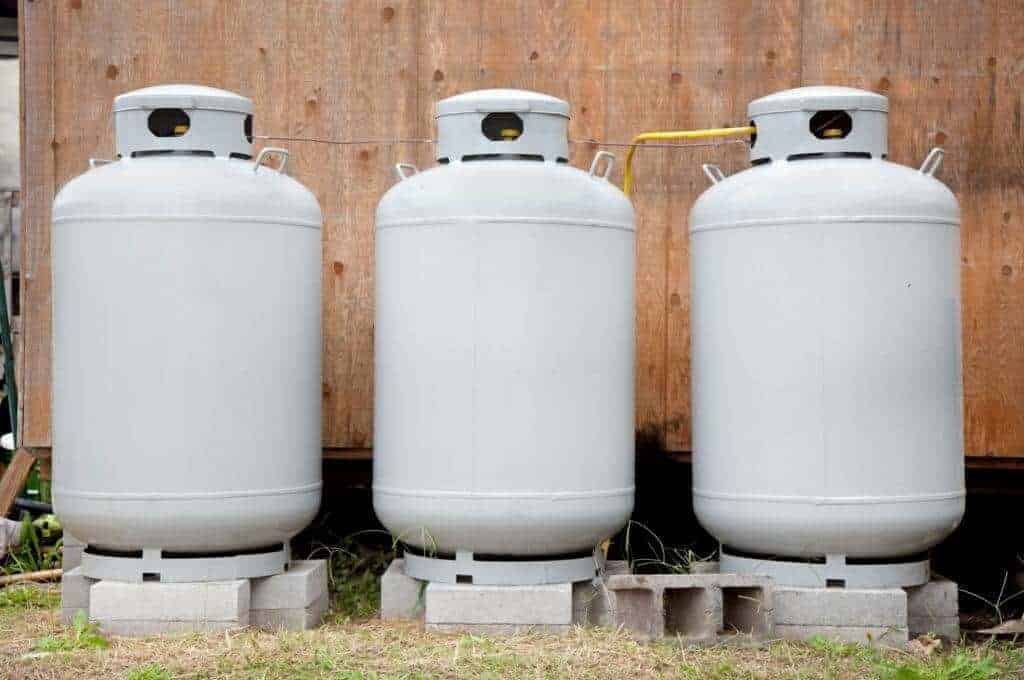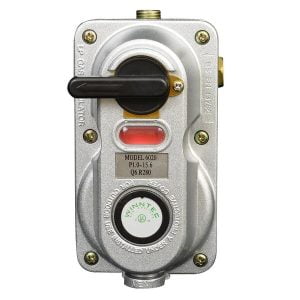When you buy through links on our site, we may earn an affiliate commission, Read More.
A big annoyance to all RV owners is to see RV propane not flowing properly to appliances. Fortunately, there are few easy fixes that you can try to resolve the current propane issue, as well as prevent all the future ones in the process.
For your convenience, we have designed the whole blog post dedicating to the RV propane flowing issue. All that, with the help of different scenarios, making a detailed explanation and some effective step by step solution.
Here are the things you should check if you are having propane flowing problem:
- Checking the propane tank and ensuring the primary valve is fully open.
- Examining the pressure regulator in the main gas line.
- Checking the propane excess flow controller
- Making sure your propane detector is turned on.
RV Propane Not Flowing: Steps To Troubleshoot
1. Check The Propane Tank And Ensure The Primary Valve Is Fully Open
This is an obvious one and first thing you should check on. Many people think the valve is on; as they turned it on before getting into the van.
In reality, it does not seem to be the case most of the time. It is not a question of competence here. Rather we are trying to say that, a lot can happen in between, when you are on the road. Allow us to draw some simple representation for you to understand.
Let’s say you are planning to travel with your partner. And you have turned the valve on the night before the journey, thinking you may forget the next day.
If your partner is not aware of your concern, it’s not entirely impossible to turn it off due to safety issues. From his/her perspective it makes sense. As flammable the propane can be, it’s not wise to leave it on unattended.
So the scenario suggests that even if you are absolutely sure your propane tank is full but has no gas flow, you should check the primary valve nonetheless.
Another circumstance you can run into is at the time of refueling. Whenever you are at the gas station, you may have seen signs to turn off the propane while on the premises. Individuals working there will also advise and check your system, whether it’s on or not.
All these are for preventing potential life hazards. It’s no surprise that it’s even illegal in some states to use propane-powered appliances in gas stations. Illegal or not, you shouldn’t be using propane either when you need to refuel between travel. It’s for your own safety.
It’s more likely that the attendant at the station may turn off your propane primary valve to follow protocol. They might as well forget to notify of their action or simply don’t want any complication arguing over it. So that’s another good reason for checking the valve if the propane stove is not lighting in the RV.
If you are traveling on the country’s colder side, the rule of thumb is to always keep your propane tank full. Anything less than a half tank can have a hard time maintaining the required pressure for your appliances. As a result, the stove, heater, and fridge won’t work properly.
Try to change the regulator to your other propane tank. It may restore the flow to the propane system. That’s the reason you need to ensure your tank is full before making the trip to cold places. Full tank pressure prevents propane from freezing up.
When it is time to refill your propane tank, generally, you go to the retailer. They often swap your empty tank with a full tank to save time. What could happen, in this case, is the tank that they give you, is a faulty one. And that may bring all sorts of trouble along the way.
Make sure there’s no existing problem with the tank. Try to refill your good tank instead of getting a new one. That will definitely save you from headaches related to the integrity of the tank.
Another way a propane tank could be the problem if you purchase an old tank from a discount shop. Old tanks tend to be a bit rusty sometime. So they usually repaint to hide the rust. If paint gets into the valve area, it will choke the channel and you won’t get any feedback from the tank.
Same way when planning to paint your tank, make sure you are not covering any important parts. Moreover, if you recently painted your tank and you see the propane tank valve is open but no gas, it’s Time for you to check those valves.
That said, we tried to put together all the scenarios that lead to the primary valve issue. It’s not that you will be in an exact situation like we mentioned. But it’s most likely to have one of these when you are on the road. And you will be ready for it when it happens.
2. Examine The Pressure Regulator In The Main Gas Line
Most RVs now come with two propane tanks at the front or side compartment. Both of the tanks can supply propane at high and low pressure depending on the appliance’s needs. The distribution is however handled by the two-stage regulator that controls the flow channel.
If you have already seen the Two-Stage Regulator, that usually controls two tanks on each channel. But when the trailer is big and has a lot of power-hungry appliances, there could be more than two tanks zeroing on the regulator through multiple hoes.
More hoes mean chances of leak on the connecting point. Make sure that isn’t the case with you while doing RV propane system troubleshooting.
One of the features of the Two-Stage Regulator is it operates at a semi-auto system. That explains how it switches between multiple tanks autonomously. Once you turn the regulator to the right channel, the regulator will take propane from the right tank. After it depletes completely, it will change to the left channel automatically without your intervention.
Keep in mind that, before you remove the empty tank for refilling, your regulator indicator shouldn’t be on the empty tank side. Turn it to the tank that has propane in it.
If you have been running your RV for years, you know you have used the pressure regulator regularly. It’s normal to concern yourself with how long a propane regulator lasts. One of the best RV propane regulators like Flame King usually lasts up to ten years, sometimes even more.
Nevertheless, you will see some regulators tuned up bad after only five or six years. Any manufacturing fault can be responsible for the RV propane regulator leak or clog in the whole system. This also happens due to a lack of proper maintenance and not attending to the bad signs it gives before going completely inoperable.
3. Checking The Propane Excess Flow Controller
The Excess Flow Controller or the Excess Control Valve is a safety feature in the propane fittings. It generally blocks propane flow when there is any leak. If you think about it, it’s a pretty neat safety feature. You also heard it by the name Flow Limiter or Propane Limiter.
Let’s go deep into how an Excess Flow Controller works. The valve has a tiny ball-like thing inside and a spring. Whenever there is a leak, the propane flow will be much higher than usual. Excess pressure will push the ball to a point that blocks propane flow.
Apart from leaks, other reasons may block the propane flow. One of them is Mechanical failure. If the valve is defective, it won’t function as it meant to be. It will either completely block the flow or won’t trigger when there is a leak.
There’s an easy way to test if there is a problem with your excess flow meter.
- First, turn off the main valve for 10-15 minutes.
- In the meantime open all your windows and doors. If there is a leak, you don’t want to flood your RV with propane.
- Also, make sure there is no open flame running in or around your RV.
- When you are ready, carefully reopen the main valve as steadily as you can. If you open the valve too quickly, the trigger can be tripped.
- After halfway opening the main valve, check if you can smell or use a flashlight to see the propane trail.
- If you don’t find any leaks yet still it trips, your flow limiter has a problem.
4. Ensure The Propane Detector Inside The Motorhome Is Turned On
A propane leak is never a good thing. A small amount of propane exposure can be very dangerous. If you haven’t installed a propane detector in your RV, there’s a slim chance that you would detect any leaks promptly. And you don’t want to sleep in your RV while there is a leak.
When traveling, always make sure your propane detector is kept on. The detector is generally connected with an electronic solenoid valve, which controls the propane flow. If the detector doesn’t get any power from the internal system, the solenoid won’t work. And it will Result in propane blocks.
To avoid this, you can take a look at the connection and corresponding breakers. Give it a good clean before you set on a journey. If the alarm trips, turn off the main valve first then try to pinpoint. RV propane leak repair can be easy with sealant when you have the exact location. Otherwise, it’s best to consult a professional.
If your RV doesn’t come with a propane detector, you can go for an aftermarket solution. Kidde Propane Detector is one of the best devices on the market with over a thousand reviews.
How To Tell If An RV Propane Regulator Is Bad?
Most camper propane regulator problems won’t start to show before 5 or 6 years of installation. Some regulators come with a manufacturing defect in the unit, some turn bad with ages. But some signs will help you to get ready for RV propane regulator troubleshooting.
Here are some of the signs for you to keep your eyes on.
- You will see yellow, sometimes a weak orange flame on the burner.
- You may hear weird sounds when turning it on/off.
- The Flame may float overhead of the burner.
- Sudden flame at the stove’s air intake.
- Black powder/flakes Buildup on the stove.
Any of these are strong signals for the RV propane regulator problem. Be sure to take care of that by resetting your regulator. If that doesn’t help, seek professional support.
How To Reset An RV Pressure Regulator?
The pressure regulator in the RV plays a huge role in controlling propane flow and a safety measure. All the features you see in a propane tank like flow limiter is also built-in a pressure regulator. The regulator will sense excess flow and cut off propane supply for your safety.
If you feel like your regulator isn’t acting as it should be, you should try resetting the regulator. It’s just like resetting the flow limiter on the propane tank. Here’s how to test the RV propane regulator by resetting the valve.
- First of all, completely turn off the regulator valve.
- Wait 10 minutes to dissipate all the propane in all the hoses.
- Now try to slowly open the valve. In this step speed is the key. If you open the valve too fast, the internal blocking system will engage thinking there’s a leak. So turn slowly.
- If you have managed to open the valve all the way and the trigger isn’t tripped, you have just reset your pressure regulator.
Final Thoughts
You cannot deny the conveniences of propane tanks in your RV experience. It’s hard to imagine running your fridge, stove, and heater without electricity in a remote place.
Well, it has its cons and RV propane is not flowing is a common issue to have when traveling. But if you can check the propane system before traveling, it may flush out most problems before it happens.
So what are your plans to make your travel more enjoyable?



